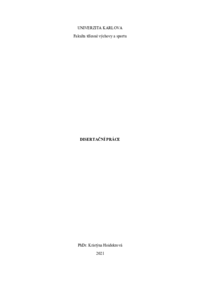Efekt roboticky asistované terapie na funkci horní končetiny v běžných denních činnostech
Effect of robot-assisted therapy on upper limb function in activities of daily living in patients after acquired brain injury
dizertační práce (OBHÁJENO)

Zobrazit/
Trvalý odkaz
http://hdl.handle.net/20.500.11956/170893Identifikátory
SIS: 197687
Kolekce
- Kvalifikační práce [9395]
Autor
Vedoucí práce
Oponent práce
Angerová, Yvona
Šorfová, Monika
Fakulta / součást
Fakulta tělesné výchovy a sportu
Obor
Kinantropologie
Katedra / ústav / klinika
Fyzioterapie
Datum obhajoby
6. 12. 2021
Nakladatel
Univerzita Karlova, Fakulta tělesné výchovy a sportuJazyk
Čeština
Známka
Prospěl/a
Klíčová slova (česky)
Roboticky asistovaná terapie, funkce horní končetiny, bimanuální přístup, Gloreha rukavice, transhemisferální inhibice, Activity of Daily Living, neuronální plasticita, bilaterální aktivace, motorická koordinaceKlíčová slova (anglicky)
Robotic assisted therapy, upper limb function, bimanual approach, Gloreha gloves, transhemispheric inhibition, Activity of Daily Living, neuronal plasticity, bilateral activation, motor coordinationNázev: Efekt roboticky asistované terapie na funkci horní končetiny v běžných denních činnostech u pacientů po získaném poškození mozku Cíle: Hlavním cílem disertační práce bylo zhodnocení a porovnání efektu dvou terapeutických přístupů s využitím roboticky asistované rukavice Gloreha Sinfonia na provádění běžných denních aktivit u pacientů po získaném poškození mozku. Metody: Práce byla koncipována jako empiricky kvantitativní výzkum, monocentrická randomizovaná kontrolovaná jednoduše zaslepená studie. Studie porovnává dvě skupiny, skupina A (n = 20) používala roboticky asistovanou rukavici Gloreha s bimanuálním přístupem, skupina B (n = 20) měla terapii s roboticky asistovanou rukavicí Gloreha s unimanuálním přístupem. Všichni pacienti byli hodnoceni pro vhodnost k zařazení a podstoupili vstupní testování (T1). Následně dle zařazení do skupin byla poskytnuta intervence (unimanuální/ bimanuální) po dobu tří týdnů (15x), poté proběhlo průběžné testování (T2) a po jednom měsíci zhodnocení (T3) přetrvání efektu roboticky asistované rukavice Gloreha. Hodnocení efektu Gloreha na provádění běžných denních aktivit a funkci horní končetiny bylo provedeno na základě Upper Extremity Motor Activity Log (UE MAL), Motor Assessment Scale (MAS), Action Research Arm Test (ARAT), Box and Block test (BBT) a...
Title: Effect of robot-assisted therapy on upper limb function in activities of daily living in patients after acquired brain injury Aims: The main aim of the thesis was to evaluate and compare the effectiveness of two therapeutic approaches using robot-assisted glove Gloreha Sinfonia to perform Activity of daily living in patients after acquired brain injury. Methods: The study is an empirical quantitative research, a monocentric randomized controlled, simply blinded study. The study compares two groups, group A (n = 20) used a robot-assisted Gloreha glove with a bimanual approach, group B (n = 20) had therapy with a robot-assisted Gloreha glove with an unimanual approach. All patients were evaluated for eligibility and underwent initial testing (T1). Patients in both groups had therapy (unimanual / bimanual) for three weeks (15x), retest (T2) was performed after completion of the intervention, and a follow-up evaluation was performed after 1 month (T3). Patients were always evaluated by the Upper Extremity Motor Activity Log (UE MAL), Motor Assessment Scale (MAS), Action Research Arm Test (ARAT), Box and Block test (BBT) and Motricity Index (MI). Results: According to the results of the MAS test in group A, there was a statistically significant improvement in upper limb function in category 8 at...
